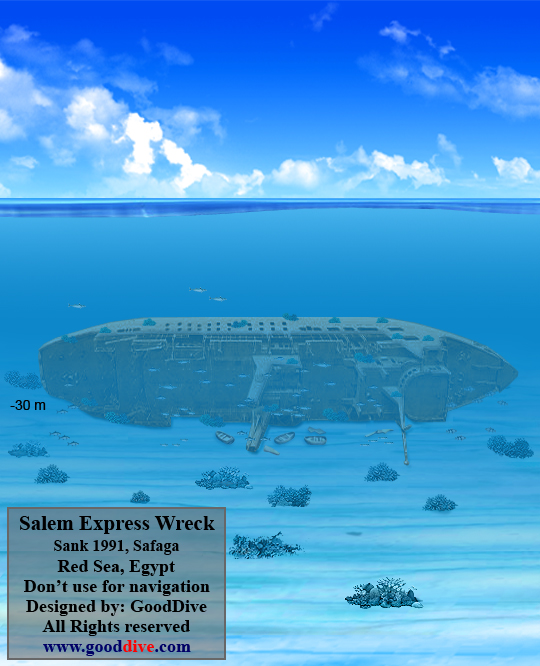|
For exploring of wrecks make sure to have the required training level and equipment!
Check with your dive center to have all necessary information for safety!
Always dive according to that and to the current conditions!

On its way from Jeddah to Safaga in the night of December 14th/15th 1991 the ferry boat Salem Express struck a reef (Hyndman Reef) close to Sha’ab Shear about 10km off Port Safaga. It’s reported that the experienced captain apparently chose a short cut instead of the normal shipping route, to make up for a delay.
The heavy collision caused a deformation of the bow and a few meters long rip in the starboard side of the hull. As the lifting mechanism of the bow door was damaged as well, the door was opened and the ferry immediately began to take in water. Because there were no safety doors, the water ran unhindered into the car decks, the ship overturned to the side and sank in about 10 minutes. Due to the speed of sinking it was not even possible to launch the lifeboats. Most of the passengers were below deck in the cabins, so they barely had a chance to save themselves.
The heavy storm and the night also made it impossible for the rescue teams to help.
Official statements were made of about 690 passengers (most of them pilgrims on their way back from Mecca), but there are different counts which are much higher (more than 1500). Only 180 people survived this disaster.
The circumstances of the tragedy, the massive loss of life, the religious factor, the impossible rescue, all that makes the Salem Express indisputably to be the most controversial wreck dive in the Red Sea.
Every diver has to decide for himself if he wants to dive at the wreck and how deeply he wants to explore it, within the consideration of his own ability and experience.
The diving boats are usually moored directly at the wreck, so it’s easy to orientate while descending on the mooring line to the wreck.
The 110m long vessel is lying with its starboard side on the seabed in a depth of 12-30m.
Everywhere around the wreck the personal remains of the passengers are scattered on the ground, bicycles, suit cases, cassette radios, TVs and carpets. Several of the life boats, still in one piece, lie in the sand the way they fell off the davits.
At the stern the two large propellers are still intact and meanwhile also colonized with marine life.
If you swim towards the bow along the deck side you will reach the restaurant. Some tables are still fixed to the floor, but most of the superstructure is collapsed. Amidships the two huge funnels are situated, bearing the vessels emblem, a capital “S†in the center of a laurel wreath.
In the bridge, located on the main deck, the remains of the control centre can be recognized through the windows. Reaching the bow section, you’ll spot the damaged, open bow door and down on the seabed the rip in the starboard side.
Pointing upwards, the enormous port side offers some interesting spots as well, like the bow thruster, a remaining anchor and the large side entry bulkhead. Through the port holes the cabins with beds and wardrobes are visible.
It is possible to penetrate the wreck from the stern entrance, but any exploration should be done according to the divers experience and with the essential respect this dive site deserves.
|